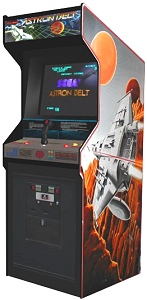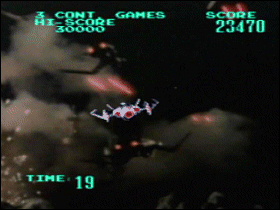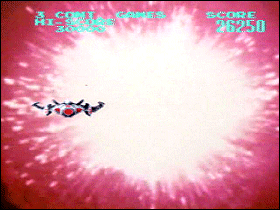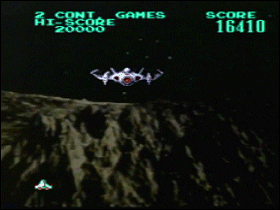 The Game: You’re a lone space pilot on patrol in the middle of an intergalactic war. In deep space, on craggy hazardous planet surfaces and at all points in between, you’re a target for enemy forces, and while you can defend yourself, danger comes from all sides without warning: enemy fire, collisions with the landscape or enemy ships, and that old standby, pilot error. The video footage in the background comes from Toei Studios’ 1979 opus Message From Earth and, somewhat surprisingly, Star Trek II. (Sega / Bally/Midway, 1983)
The Game: You’re a lone space pilot on patrol in the middle of an intergalactic war. In deep space, on craggy hazardous planet surfaces and at all points in between, you’re a target for enemy forces, and while you can defend yourself, danger comes from all sides without warning: enemy fire, collisions with the landscape or enemy ships, and that old standby, pilot error. The video footage in the background comes from Toei Studios’ 1979 opus Message From Earth and, somewhat surprisingly, Star Trek II. (Sega / Bally/Midway, 1983)
Memories: In 1983, several companies seemed to simultaneously roll out arcade games based on the engineering principle that some or all of the game’s graphics would be played by a videodisc player. In the age of videotape, videodisc technology wasn’t perfect, but it presented something that was absolutely vital for bringing pre-recorded video to a game environment: random access. Without that, any game using pre-recorded video would’ve been forced to show the same sequence of visuals no matter what the player did.
 To hear Sega insiders tell the story, Astron Belt was the first laserdisc video game to go into development. But the problem with blazing new trails is that you never know how long it’ll take you. While Astron Belt was still somewhere between ironing out the kinks and play testing, another game began its own development curve after Astron Belt and hit the market before Astron Belt…so as far as the quarter-dropping public was concerned, Dragon’s Lair was the first laserdisc game.
To hear Sega insiders tell the story, Astron Belt was the first laserdisc video game to go into development. But the problem with blazing new trails is that you never know how long it’ll take you. While Astron Belt was still somewhere between ironing out the kinks and play testing, another game began its own development curve after Astron Belt and hit the market before Astron Belt…so as far as the quarter-dropping public was concerned, Dragon’s Lair was the first laserdisc game.
The problem there is that Dragon’s Lair wasn’t really much of a game, whereas Astron Belt offers at least some actual interaction. At best,  Dragon’s Lair is the video equivalent of a choose-your-own-adventure book – if Dirk goes down the flashing corridor, turn to page 23. If Dirk steps through the wooden door instead, turn to page 84 to see what hideous death awaits him. Astron Belt uses its film footage as background material, with some limited interactive elements. The player’s ship is superimporsed over the footage, along with occasional enemy fire. Arguably, this makes Astron Belt more of a true video game than, say, Dragon’s Lair and Cliff Hanger; Astron Belt could be put over a computer-generated background and it could still essentially be the same game; the purely footage-based games couldn’t.
Dragon’s Lair is the video equivalent of a choose-your-own-adventure book – if Dirk goes down the flashing corridor, turn to page 23. If Dirk steps through the wooden door instead, turn to page 84 to see what hideous death awaits him. Astron Belt uses its film footage as background material, with some limited interactive elements. The player’s ship is superimporsed over the footage, along with occasional enemy fire. Arguably, this makes Astron Belt more of a true video game than, say, Dragon’s Lair and Cliff Hanger; Astron Belt could be put over a computer-generated background and it could still essentially be the same game; the purely footage-based games couldn’t.
 As a game play experience, though, Astron Belt is still ultimately about visual dazzle more than real interactivity. Enemy ships can swoop in and blast yoou before you’ve even really had a chance to react, making for seemingly random deaths galore. The accuracy of targeting on the pre-recorded laserdisc enemy ships is actually uncannily good, though whether or not anyone can draw a bead on something moving that fast is obviously going to depend on the player. The superimposed graphics do the job nicely, and the background footage is well chosen. Though much of the footage comes from the 1979 Japanese movie Message From Earth, there are also snippets of footage from 1982’s Star Trek II: The Wrath Of Khan,
As a game play experience, though, Astron Belt is still ultimately about visual dazzle more than real interactivity. Enemy ships can swoop in and blast yoou before you’ve even really had a chance to react, making for seemingly random deaths galore. The accuracy of targeting on the pre-recorded laserdisc enemy ships is actually uncannily good, though whether or not anyone can draw a bead on something moving that fast is obviously going to depend on the player. The superimposed graphics do the job nicely, and the background footage is well chosen. Though much of the footage comes from the 1979 Japanese movie Message From Earth, there are also snippets of footage from 1982’s Star Trek II: The Wrath Of Khan,  which probably indicates that the development process for Astron Belt stretches back to 1982, at which time Sega of America was owned by Gulf + Western, which also owned Paramount Pictures at the time (this alliance also resulted in Sega’s 1982 Star Trek arcade game). But by the time Astron Belt was finally ready to appear in arcades, Sega’s American operation had changed hands and was now owned by competitor Bally/Midway.
which probably indicates that the development process for Astron Belt stretches back to 1982, at which time Sega of America was owned by Gulf + Western, which also owned Paramount Pictures at the time (this alliance also resulted in Sega’s 1982 Star Trek arcade game). But by the time Astron Belt was finally ready to appear in arcades, Sega’s American operation had changed hands and was now owned by competitor Bally/Midway.

